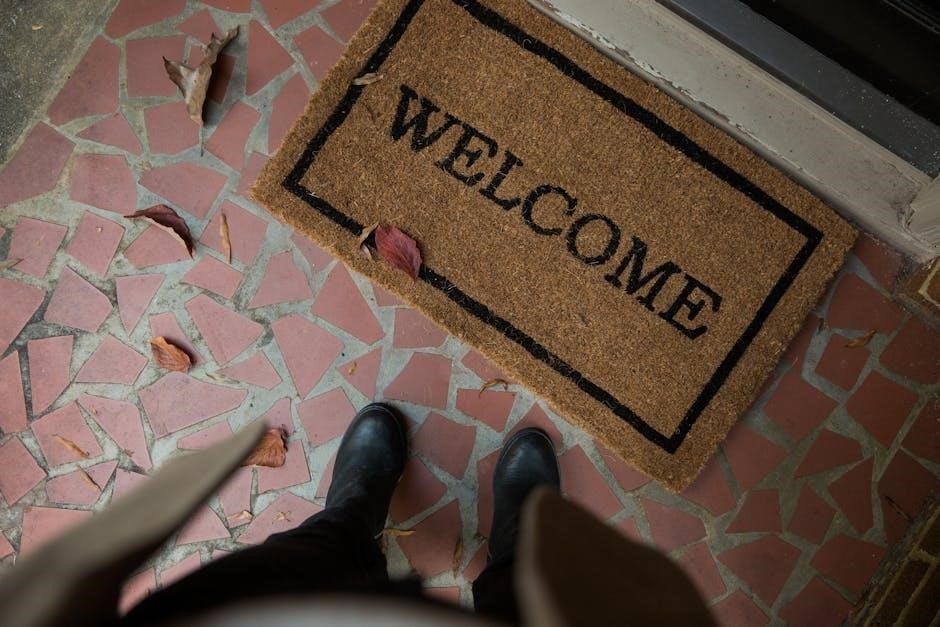Choosing the right entryway rug size is crucial for both functionality and aesthetics․ A well-sized rug enhances the space’s appearance while providing comfort and durability․ This guide helps you select the perfect fit, covering measurement tips, shape options, and material recommendations to ensure your entryway looks inviting and functions flawlessly․
1․1 Why Rug Size Matters in Entryways
The size of an entryway rug plays a critical role in both functionality and aesthetics․ A rug that is too small may fail to protect the floor adequately, while one that is too large can overwhelm the space․ Proper sizing ensures the rug complements the room’s design without obstructing doorways or walkways․ It also provides a safe and welcoming transition into the home․ Choosing the right size enhances the entryway’s practicality and visual appeal, ensuring it balances with the surrounding decor and proportions of the space․
1․2 Factors Affecting Entryway Rug Size
Several factors influence the ideal size of an entryway rug, including the room’s dimensions, door placement, and furniture arrangement․ The rug should fit comfortably without obstructing doors or pathways․ Additionally, personal style and desired floor coverage play a role․ For instance, smaller entryways may require a compact 2×3 or 3×5 rug, while larger spaces can accommodate 5×7 or 6×9 options․ The rug’s shape, whether rectangular, round, or a runner, also depends on the entryway’s layout and traffic flow․ Balancing these elements ensures the rug enhances both functionality and visual harmony․
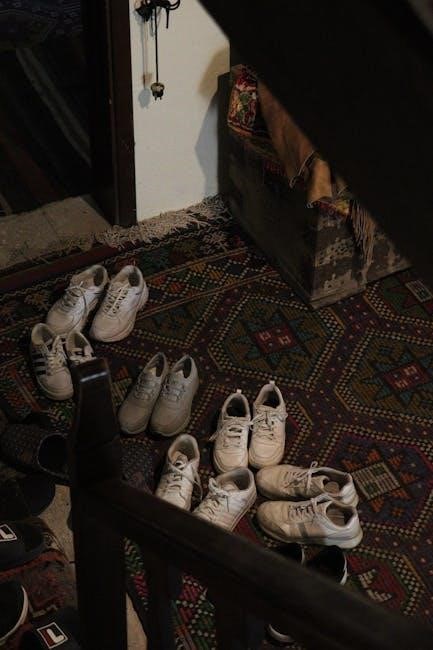
How to Measure Your Entryway
Measuring your entryway accurately ensures the rug fits perfectly․ Measure the width and length, considering doorways, to determine the best size for your space․
2․1 Step-by-Step Measuring Guide
To measure your entryway accurately, start by determining the width and length using a measuring tape․ Measure the width at the narrowest point, typically in front of the door․ Next, measure the length from the door to where the entryway opens into the rest of the home․ Subtract 24 inches from both dimensions to ensure the rug fits comfortably without obstructing doorways or traffic flow․ For example, if your entryway is 4 feet wide and 8 feet long, the maximum rug size would be 2×6 feet․ This leaves 12 inches of floor space on all sides, creating a balanced look․
2․2 Tools and Tips for Accurate Measurement
Use a sturdy measuring tape to ensure precise dimensions․ Measure the width at the narrowest point and the length from the door to the opening․ For accuracy, consider door swings and nearby furniture․ Subtract 24 inches from both measurements to allow 12 inches of floor space on all sides․ Use graph paper to sketch your entryway layout, marking doors, walls, and obstructions․ This visual aid helps in selecting the best rug size and shape․ Always double-check measurements to avoid errors and ensure the rug fits seamlessly without obstructing traffic or door functionality․
Standard Entryway Rug Sizes
Standard entryway rug sizes include small options like 2×3, 3×5, or 2×6 runners, medium 4×6 or 5×7 rugs, and large 5×8 or 6×9 rugs for bigger spaces․
3․1 Small Entryways: 2×3, 3×5, or 2×6 Runner
For small entryways, a 2×3, 3×5, or 2×6 runner rug is ideal․ These sizes fit neatly in compact spaces, providing coverage without overwhelming the area․ A 2×3 rug is perfect for tiny entryways, while a 3×5 rug offers slightly more coverage, ideal for small foyers with a console table or bench․ The 2×6 runner is great for narrow hallways or entryways with a longer footprint․ Ensure the rug leaves 12-24 inches of floor space around it for a balanced look․ These sizes protect the floor from dirt and moisture effectively while adding style and warmth․
3․2 Medium Entryways: 4×6 or 5×7 Rugs
For medium-sized entryways, a 4×6 or 5×7 rug is ideal․ These sizes provide ample coverage without overwhelming the space․ A 4×6 rug fits neatly in medium foyers, while a 5×7 rug offers more coverage, making it perfect for slightly larger areas․ Both sizes work well in square or rectangular entryways, leaving 12-24 inches of floor space around the edges․ This ensures a balanced look and protects the floor from dirt and moisture․ The 5×7 rug is also versatile, fitting horizontal or vertical layouts depending on the space․ It’s a practical choice for medium-sized entryways․
3․3 Large Entryways: 5×8 or 6×9 Rugs
For larger entryways, a 5×8 or 6×9 rug is the ideal choice, offering ample coverage and a grand appearance․ These sizes are perfect for spacious foyers or double-door entryways, creating a welcoming atmosphere while protecting the floor․ A 5×8 rug works well in rectangular areas, while a 6×9 rug suits slightly larger spaces, ensuring a balanced look․ Both sizes allow for 12-24 inches of floor space around the edges, maintaining harmony and functionality․ These rugs are durable and stylish, making them a great fit for high-traffic areas․ They anchor the space beautifully, complementing both modern and traditional designs․

Choosing the Right Shape for Your Entryway Rug
Selecting the right rug shape enhances functionality and style․ Consider your entryway’s layout and personal preference to choose between runners, rectangular, round, or oval rugs for a perfect fit․
4․1 Runners vs․ Rectangular Rugs
Runners and rectangular rugs serve different purposes in entryways․ Runners are ideal for narrow, elongated spaces like hallways, offering a sleek, streamlined look․ They are typically long and narrow, with standard sizes like 2․5×8 or 2․5×10 feet, making them perfect for high-traffic areas where length is more important than width․ On the other hand, rectangular rugs are better suited for wider entryways or foyers, providing a more traditional look․ They come in sizes such as 3×5 or 4×6 feet, offering ample coverage and a cozy feel․ Choose a runner for a hallway or a rectangular rug for a broader space to ensure the best fit and functionality․
4․2 When to Use Round or Oval Rugs
Round or oval rugs can add a unique touch to your entryway, depending on the space․ Use round rugs in square areas for a cozy feel or to complement circular lighting fixtures․ Oval rugs suit rectangular rooms, offering balance and harmony․ Consider the entryway’s shape and lighting when choosing; round rugs work well under circular fixtures, while oval rugs match rectangular spaces․ Ensure the rug size fits the area, leaving enough floor space for a balanced look․ Personal style and space layout also play a role in this decision․
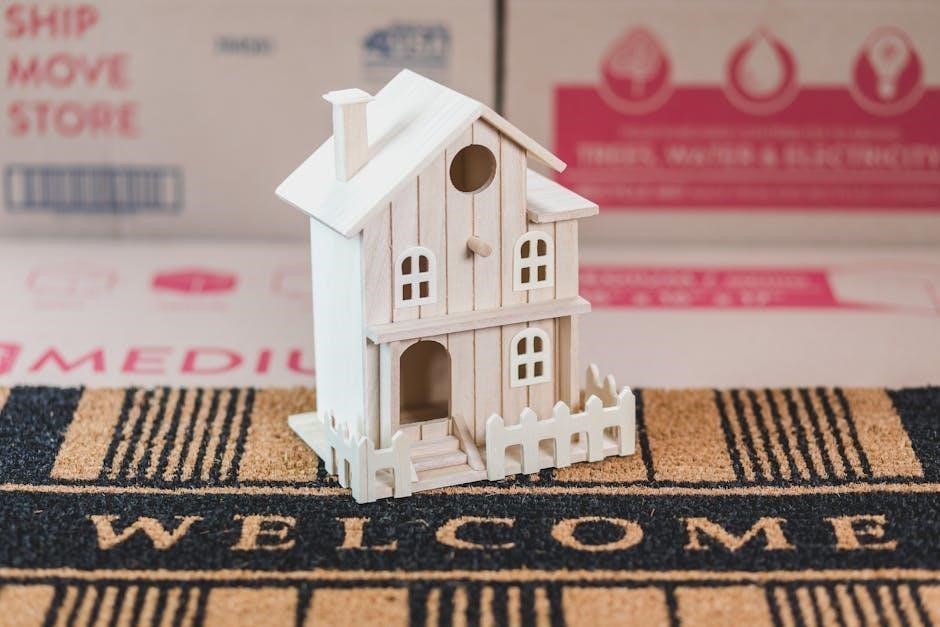
Best Materials for Entryway Rugs
Natural fibers like jute and sisal are durable and moisture-resistant, while synthetic materials such as polyester and nylon offer stain resistance․ Wool is a designer favorite for its style and resilience․
5․1 Natural Fibers: Jute and Sisal
Jute and sisal rugs are popular for entryways due to their durability and natural beauty․ They effectively catch dirt and moisture, making them practical for high-traffic areas․ These rugs are easy to maintain—simply shake them out or vacuum regularly․ However, they absorb moisture, so they require proper drying after wet conditions to prevent mold․ Ideal for eco-conscious homeowners, jute and sisal rugs add warmth and texture while protecting floors․ They are a great choice for entryways needing a rustic, organic look and feel․
5․2 Synthetic Fibers: Polyester, Nylon, Olefin
Synthetic fibers like polyester, nylon, and olefin are excellent choices for entryway rugs due to their durability and resistance to stains and moisture․ These materials are easy to clean and maintain, making them ideal for high-traffic areas․ They come in vibrant colors and intricate designs, offering versatility for various decor styles․ While they may show wear over time, their affordability and practicality make them a great option for homeowners seeking a balance between style and functionality in their entryway․
5․3 Wool: The Designer’s Choice
Wool is a top choice for designers due to its exceptional durability and luxurious appearance․ It is naturally stain- and moisture-resistant, making it ideal for high-traffic entryways․ Wool rugs are easy to maintain, as they can be spot-cleaned with soap and water․ They also retain their color and texture well, resisting fading and wear․ For added protection, pairing wool rugs with a high-quality rug pad is recommended to prevent slipping and extend their lifespan․ This material blend of style and practicality makes wool a favorite for entryway rugs․
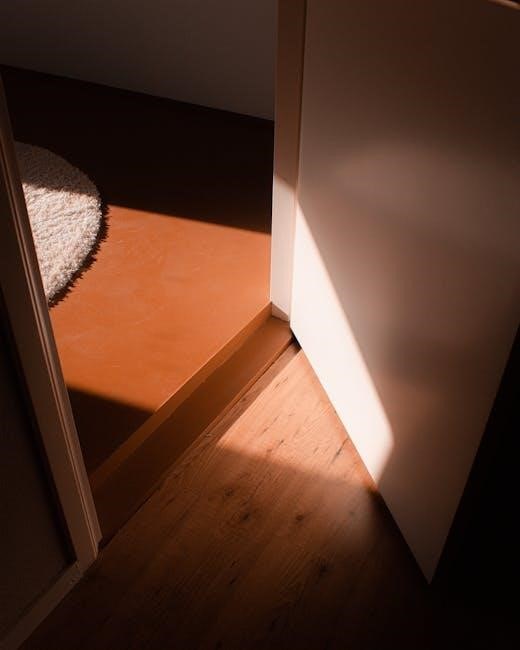
Placement and Layout Tips
Position the rug to center under lighting fixtures, matching its shape to the light for a cohesive look․ Ensure the rug is large enough to fit under furniture․
6․1 Positioning the Rug for Maximum Coverage
Positioning the rug correctly ensures optimal coverage and visual balance․ Place the rug so it extends 12-24 inches from the door on all sides, creating a welcoming area․ Center the rug under lighting fixtures like chandeliers or pendants to enhance harmony․ For long, narrow entryways, align the rug vertically to guide foot traffic․ In square spaces, position it symmetrically to balance the area․ Always ensure the rug is large enough to accommodate furniture, such as console tables, without overcrowding․ Proper placement protects flooring and adds a polished look to your entryway․
6․2 Coordinating with Lighting Fixtures
When coordinating your entryway rug with lighting fixtures, consider size, shape, and placement for a harmonious look․ Center the rug under lighting fixtures like chandeliers or pendants to create balance․ For round fixtures, a round or oval rug complements the shape, while rectangular rugs align well with linear fixtures․ Ensure the rug extends 12-24 inches from the door and walls for a balanced appearance․ Match the rug’s style and color to the lighting’s aesthetic, such as pairing a modern rug with sleek fixtures or a traditional rug with ornate designs․ Symmetry enhances appeal, but intentional asymmetry can also work․ Ultimately, the rug should define the entryway, complementing the lighting to create a welcoming and cohesive space․
Maintenance and Cleaning Tips
Regular vacuuming and spot cleaning with mild soap keep your entryway rug looking its best․ Use rug pads for protection and longevity․
7․1 Regular Cleaning and Spot Treatment
Regular cleaning is essential for maintaining your entryway rug’s appearance․ Vacuum the rug frequently to remove dirt and debris․ For spot treatment, use a mild soap solution to blot spills immediately, avoiding harsh chemicals that could damage the fibers․ For tougher stains, let the solution sit briefly before rinsing and blotting dry․ Synthetic rugs can often be cleaned with a damp cloth, while natural fiber rugs may require shaking outdoors․ Always dry rugs thoroughly to prevent mold or mildew․
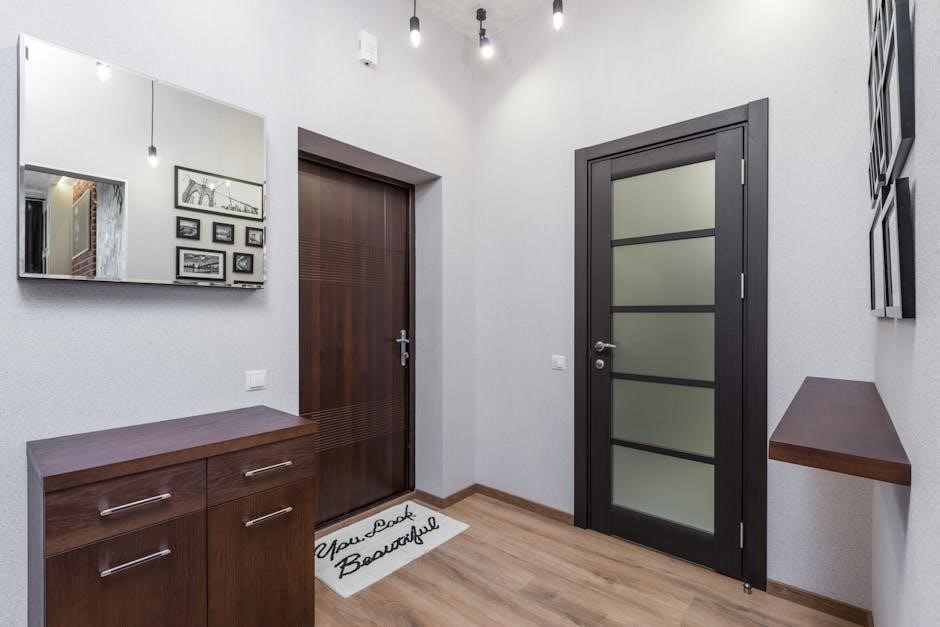
7․2 Using Rug Pads for Protection
Rug pads are essential for protecting both your entryway rug and flooring․ They prevent the rug from shifting, sliding, or bunching, ensuring safety and stability․ Pads also add cushioning for comfort underfoot and help extend the rug’s lifespan․ Choose a pad specifically designed for your rug’s material and size to ensure a snug fit․ This extra layer not only protects the rug from wear and tear but also shields the floor from potential damage․ Additionally, rug pads can help prevent moisture buildup, reducing the risk of mold or mildew․
Frequently Asked Questions
This section addresses common queries about entryway rug sizes, materials, and maintenance, offering practical advice to help you make informed decisions for your space․
8․1 Should I Choose a Runner or an Area Rug?
Choosing between a runner and an area rug depends on your entryway’s layout․ Runners are ideal for long, narrow spaces, such as hallways, offering a sleek, functional solution․ Area rugs, like 3×5 or 4×6 sizes, suit smaller, wider spaces, providing a cozy feel․ Consider traffic flow and door placement—runners work best under doors, while area rugs define the entryway area․ Measure your space and choose based on how much floor you want to cover․ Either option can enhance both style and functionality, ensuring a welcoming entrance․ The decision ultimately depends on your specific entryway dimensions and design preferences․
8․2 How Do I Protect My Rug from Moisture Damage?
To protect your entryway rug from moisture damage, place a doormat outside for shoe wiping and use a rug pad for added cushioning and moisture protection․ Regularly vacuum and spot clean to prevent dirt buildup, which can trap moisture․ For natural fiber rugs like jute or sisal, ensure they dry thoroughly after cleaning to avoid mold․ Consider using water-resistant treatments for synthetic rugs․ If the rug gets wet, shake off excess water and allow it to air dry completely․ Placing a bench or shoe rack can also reduce moisture contact, helping extend the rug’s lifespan․
